| Author |
Message |
Matt Lewis

Location: England Joined: 01 May 2007
Posts: 88
|
 Posted: Mon 29 Jun, 2009 7:49 am Post subject: Seax Finished Posted: Mon 29 Jun, 2009 7:49 am Post subject: Seax Finished |
 |
|
Well I finally finished my Seax ! a combination of no spare time and alot of bad luck meant it's completion has been delayed by months. I'm so pleased it is done !
It's about 19-20 inches long,and It has been made with materials that could be considered similar or close to what would have been available historically , it is a laminate of medium carbon steel cutting edge sandwiched between wrought iron, should make for a very tough blade, it's still hard enough to take and hold a good working edge too.
I would have liked to use bronze for the fittings for the sake of authenticity , however I was unable to obtain any at short notice for when I could steal some time in the workshop, so it is brass instead, the grip is red deer antler.
Cheers,
Matt
 Attachment: 195.92 KB Attachment: 195.92 KB
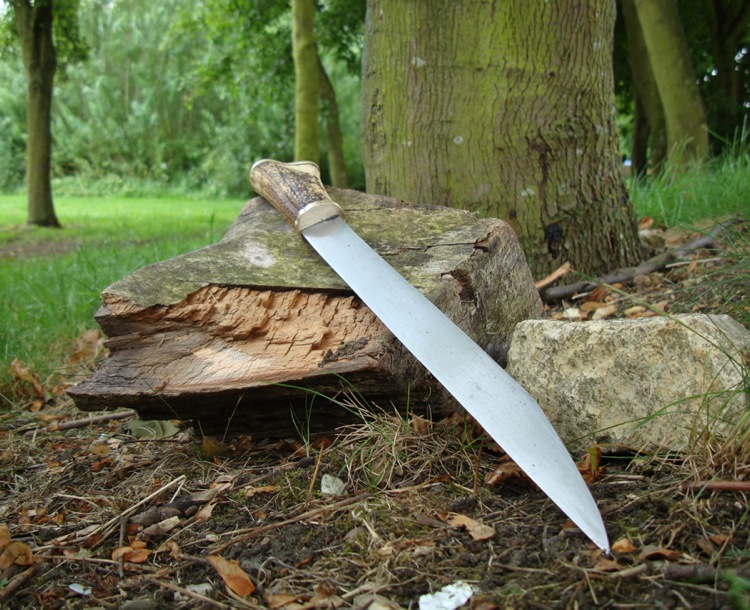
 Attachment: 197.88 KB Attachment: 197.88 KB
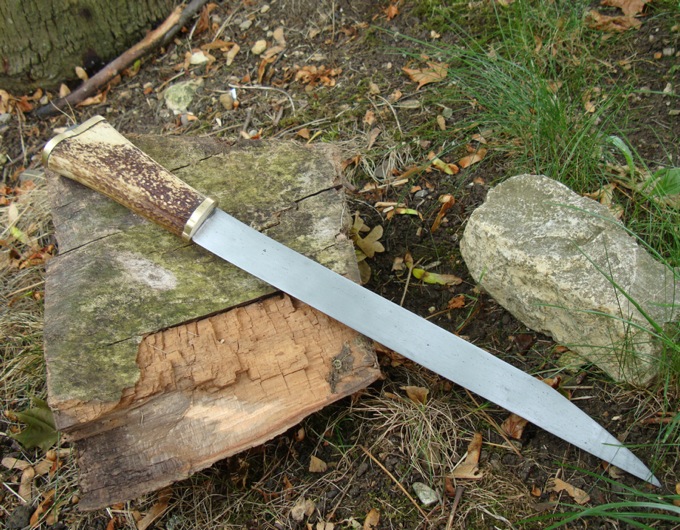
 Attachment: 154.14 KB Attachment: 154.14 KB
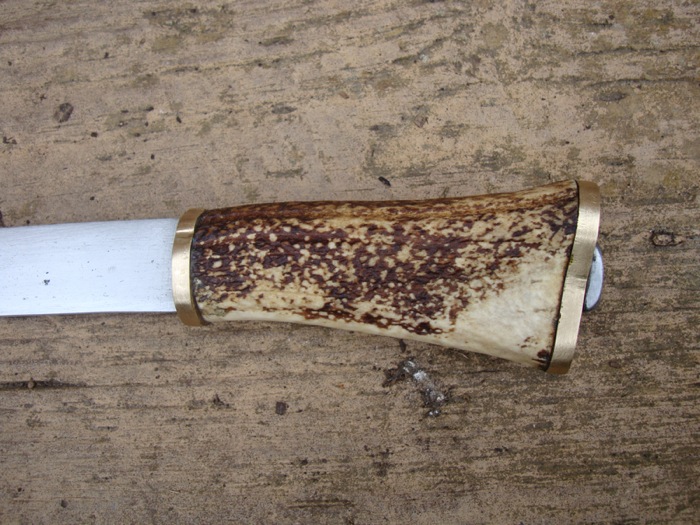
"Perfection is not when there is nothing left to add, but when there is nothing left to take away."
|
|
   |
 |
|
Tim Lison
|
 Posted: Mon 29 Jun, 2009 8:57 am Post subject: Posted: Mon 29 Jun, 2009 8:57 am Post subject: |
 |
|
|
Really nice! It looks like it'll be comfortable to hold with that grip. I love the shape of the blade.
|
|
  |
 |
M. Eversberg II

|
 Posted: Mon 29 Jun, 2009 9:34 am Post subject: Posted: Mon 29 Jun, 2009 9:34 am Post subject: |
 |
|
That is very beautiful work.
M.
This space for rent or lease.
|
|
      |
 |
Matt Lewis

Location: England Joined: 01 May 2007
Posts: 88
|
 Posted: Mon 29 Jun, 2009 12:30 pm Post subject: Posted: Mon 29 Jun, 2009 12:30 pm Post subject: |
 |
|
Thanks chaps
It is indeed very comfy in the hand,looking forward to 'testing' it on some stuff at some point.
I'm hoping to do a pattern welded one next,i may even try my hand at some inlay, will have to see ............
M.
"Perfection is not when there is nothing left to add, but when there is nothing left to take away."
|
|
   |
 |
|
Jeroen Zuiderwijk
Industry Professional
|
|
   |
 |
|
K J Seago
|
 Posted: Tue 30 Jun, 2009 12:58 am Post subject: Posted: Tue 30 Jun, 2009 12:58 am Post subject: |
 |
|
i think what one of your other commenters meant to say was that nearly all (if not all) antler peices from the periods that seaxes were in use were deliberately rasped to remove the outer texture,smoothed off and generally decorated.
sorry if that sounded a bit negative,the blade looks good,the fitting of the handle looks good,and your peening is good too
(this all coming from a bone and antler worker!)
just another student of an interesting subject, 
|
|
  |
 |
|
Jeroen Zuiderwijk
Industry Professional
|
 Posted: Tue 30 Jun, 2009 1:25 am Post subject: Posted: Tue 30 Jun, 2009 1:25 am Post subject: |
 |
|
| K J Seago wrote: | | i think what one of your other commenters meant to say was that nearly all (if not all) antler peices from the periods that seaxes were in use were deliberately rasped to remove the outer texture,smoothed off and generally decorated. |
No, no antler at all, at least not on non-scandinavian saxes such as the broken back type. Scandinavian knives and saxes had bone or antler in the hilts, but in the rest of Europe for all saxes (at least the few hundreds I've seen with hilt remains) the hilt was nearly always wood, with the odd exception of horn or ivory (one small broken back sax).
Jeroen Zuiderwijk
- Bronze age living history in the Netherlands
- Barbarian metalworking
- Museum photos
- Zip-file with information about saxes
|
|
   |
 |
|
K J Seago
|
 Posted: Tue 30 Jun, 2009 9:13 am Post subject: Posted: Tue 30 Jun, 2009 9:13 am Post subject: |
 |
|
| Quote: | | No, no antler at all, at least not on non-scandinavian saxes such as the broken back type. Scandinavian knives and saxes had bone or antler in the hilts, but in the rest of Europe for all saxes (at least the few hundreds I've seen with hilt remains) the hilt was nearly always wood, with the odd exception of horn or ivory (one small broken back sax). |
Antler was used everywhere that deer of the period existed,most of the time the ones we find now have no handle because they were all made of organic materials.
just another student of an interesting subject, 
|
|
  |
 |
M. Eversberg II

|
 Posted: Tue 30 Jun, 2009 12:27 pm Post subject: Posted: Tue 30 Jun, 2009 12:27 pm Post subject: |
 |
|
| Jeroen Zuiderwijk wrote: | | K J Seago wrote: | | i think what one of your other commenters meant to say was that nearly all (if not all) antler peices from the periods that seaxes were in use were deliberately rasped to remove the outer texture,smoothed off and generally decorated. |
No, no antler at all, at least not on non-scandinavian saxes such as the broken back type. Scandinavian knives and saxes had bone or antler in the hilts, but in the rest of Europe for all saxes (at least the few hundreds I've seen with hilt remains) the hilt was nearly always wood, with the odd exception of horn or ivory (one small broken back sax). |
I wonder why this is so? Fashion? I'll admit freely I've never used anything with real antler handles. How does deer antler and "bone" hold up compared to wood? How different are they from "horn"?
M.
This space for rent or lease.
|
|
      |
 |
|
Dustin R. Reagan
|
 Posted: Tue 30 Jun, 2009 12:56 pm Post subject: Posted: Tue 30 Jun, 2009 12:56 pm Post subject: |
 |
|
| M. Eversberg II wrote: | | Jeroen Zuiderwijk wrote: | | K J Seago wrote: | | i think what one of your other commenters meant to say was that nearly all (if not all) antler peices from the periods that seaxes were in use were deliberately rasped to remove the outer texture,smoothed off and generally decorated. |
No, no antler at all, at least not on non-scandinavian saxes such as the broken back type. Scandinavian knives and saxes had bone or antler in the hilts, but in the rest of Europe for all saxes (at least the few hundreds I've seen with hilt remains) the hilt was nearly always wood, with the odd exception of horn or ivory (one small broken back sax). |
I wonder why this is so? Fashion? I'll admit freely I've never used anything with real antler handles. How does deer antler and "bone" hold up compared to wood? How different are they from "horn"?
M. |
In my experience, dried cow femur is less flexible (more prone to cracking, chipping and splitting), about as hard or slightly harder, more dense (heavier), and more homogeneous (therefore easier to finish) than many commonly used species of wood. Your mileage will vary with both the type of bone and wood and how they were prepared.
I don't have any experience thus far with antler.
Personally, i really like horn. I see it as the plastic of its time. You can heat it up and mold & form it, It is really resilient and tough (resists chipping and cracking, but it may split). It's easy to finish (polishes up really nice).
Dustin
|
|
  |
 |
|
Dustin R. Reagan
|
 Posted: Tue 30 Jun, 2009 1:10 pm Post subject: Posted: Tue 30 Jun, 2009 1:10 pm Post subject: |
 |
|
| Jeroen Zuiderwijk wrote: | | Nice blade. Just mind that this kind of grip is not historical for saxes (despite the fact that nearly everyone in reenactment uses such hilts!). |
To be brutally honest:
I like the finished piece a lot. However, the proportions of the blade seem a bit 'off' to me. If I am wrong, someone more knowledgeable (Jeroen?) please correct me, but from the photos I've seen, most broken back seaxes had a higher point-section to blade-length ratio, most had a more pronounced 'reverse taper' (become wider to the point where the back 'breaks'), and had somewhat of a 'belly' or slight curve along the edge of the blade -- especially near the tip. Furthermore, the back edge of the tip tended to have a slight concave recurve to it, while yours appears to have convex curve. For example: http://www.myArmoury.com/images/features/pic_seax07.jpg
Don't take this too harshly, it's a nice piece, and I could be off-base here!
Thanks for posting,
Dustin
|
|
  |
 |
|
K J Seago
|
 Posted: Tue 30 Jun, 2009 2:55 pm Post subject: Posted: Tue 30 Jun, 2009 2:55 pm Post subject: |
 |
|
with antler it can really depend on what deer it comes from,but generally,the reds have a good level of thickness to work small peices from and probably best for knife handles as the change from cellular marrow to solid material changes at a resonable pace (reindeer does this quicker so you can get more to work with for composite combs for instance)
fallow is far more solid but more flakey i've found but i had used aged fallow antler,roe is pointless with topics such as these because the size and pearling(nobbly bits). the best way to get bone is either to let ants eat the fleshy left overs or lightly boils it and maybe bleaching it,cooked bone being far too britle for most things,but mostly if you want to know more ask the boneworkers god, Arthur MacGregor in Bone Antler Ivory and horn, A typology of skeletal materials.
just another student of an interesting subject, 
|
|
  |
 |
|
K J Seago
|
 Posted: Tue 30 Jun, 2009 3:00 pm Post subject: Posted: Tue 30 Jun, 2009 3:00 pm Post subject: |
 |
|
Horn is bloody lovely but to tell the truth,currently i have limited knowledge on the stuff,but yes it was very flexible,on what it can be used for and literally! but i do think it is sometimes awkward to sort and sometimes,when well done, very practical and beautiful as well-and thats not a word i use often!
just another student of an interesting subject, 
|
|
  |
 |
Kirk Lee Spencer

|
 Posted: Tue 30 Jun, 2009 3:08 pm Post subject: Re: Seax Finished Posted: Tue 30 Jun, 2009 3:08 pm Post subject: Re: Seax Finished |
 |
|
| Matt Lewis wrote: | Well I finally finished my Seax ! a combination of no spare time and alot of bad luck meant it's completion has been delayed by months. I'm so pleased it is done !...
Cheers,
Matt |
Hey Matt...
Great work!
It is great to have more smiths working to make period blades.
I think that that may be the reason we make comments about authenticity. With the amount of work to make a Iron/Steel sandwich blade, it moves us to want a hilt to match in authenticity. That is not to say that the work as finished is not very nice. I often find that it is when their is real quality work that temps me to offer constructive criticism. I like it as is, but if it were mine I would get my dremel out and in an hour or so take the antler hilt down down to streamline if just a bit. Not just to continue the flow of the blade lines, the upward bulge at the top of the base would most likely rub the wirst using the seax for camp duties. (when I look at handles on kitchen knives they always are rounded downward in this area). I would also take down the thickness of the antler near the forte of the blade to make it easier to slide into the typical seax scabbard. I have done a little photoshop to show what I mean. Just my take on it.... I really like the blade (I'll post some historical examples in another post)
I look forward to seeing some of your patternwelding.
take care
ks
 Attachment: 97.81 KB Attachment: 97.81 KB
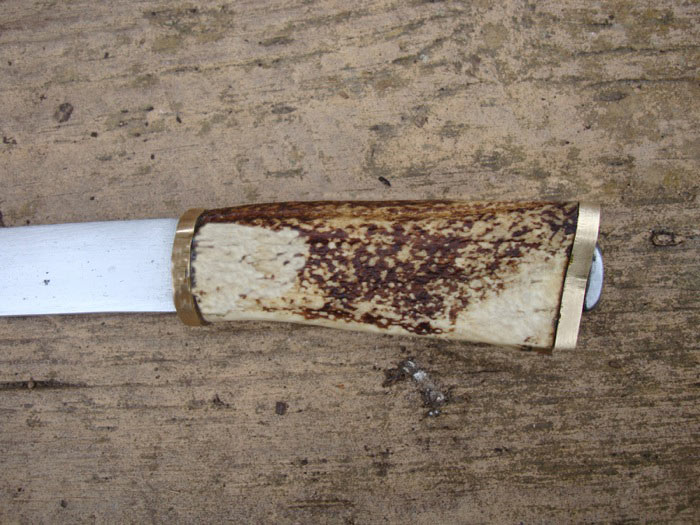
 Attachment: 86.78 KB Attachment: 86.78 KB
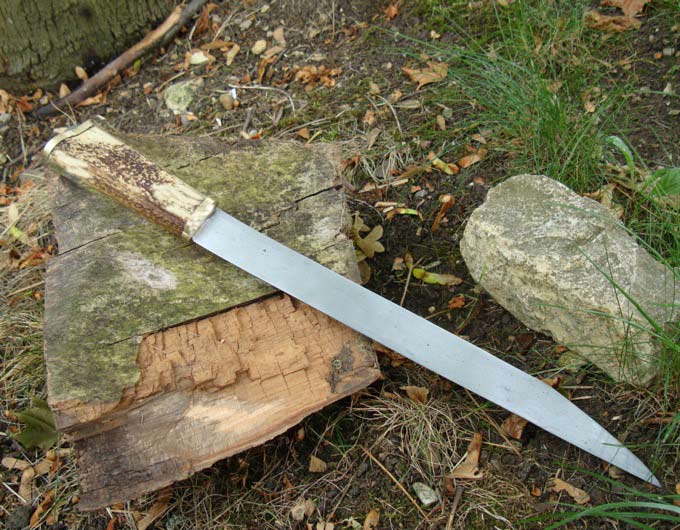
Two swords
Lit in Edenís flame
One of iron and one of ink
To place within a bloody hand
One of God or one of man
Our souls to one of
Two eternities
|
|
  |
 |
|
K J Seago
|
 Posted: Tue 30 Jun, 2009 3:17 pm Post subject: Posted: Tue 30 Jun, 2009 3:17 pm Post subject: |
 |
|
i would say that when it comes to the shape on the handle i have found the shape of pukko? knoives to be seemingly descended from the seax and the widening at the end has a purpose as to using as a pivot for choping wood when swinging the thing(as described by some bloke on a video on u tube) the item we are discussing varied in size from something small enough to scrape your fingernails with to something capable of splitting a boars skull and being as large as a sword,they vary so much and are talked about little generally,im enjoying this! 
just another student of an interesting subject, 
|
|
  |
 |
|
K J Seago
|
 Posted: Tue 30 Jun, 2009 3:20 pm Post subject: Posted: Tue 30 Jun, 2009 3:20 pm Post subject: |
 |
|
and just to add that the shape also means that the knife is easier drawn from the sheath that can cover all but the last bit of the handle,as with the more modern scandinavian blades
just another student of an interesting subject, 
|
|
  |
 |
Jim Adelsen
Industry Professional

|
|
   |
 |
Matt Lewis

Location: England Joined: 01 May 2007
Posts: 88
|
 Posted: Tue 30 Jun, 2009 4:54 pm Post subject: Posted: Tue 30 Jun, 2009 4:54 pm Post subject: |
 |
|
hey
Thanks for all the feedback,much appreciated ,especially the effort spent photoshopping an edited version, thanks.
I'm kinda of the opinion that so many Sax's etc have zero grip material left, it is far from Impossible that antler could/would be used.
It Is easy enough to work with and red deer are (as far as I am aware) pretty prolific in the uk . I can't think of a good reason why they would not use it as a grip material.
the texture on the surface and the shapes that you can choose out of a piece of antler allow you to make some very natural ,grippy and comfortable grips.
This one sits nicely in the hand , there are no problems with rubbing on the wrist (at least on my hand) I do agree the area around the bolster could be a little slimmer :o) as for the butt end I really like the shape and as mentioned before it does make it a whole lot easier to extract from a classic sax sheath.,not to mention that it helps with edge alignment too .
I think for my next one I will try and directly copy the shape of an original that appeals to me , that should cheer up the authentinazis and give me piece of mind ;o)
I'm very open for suggestions for my next attempt . blade shape/size/handle type
cheers guys,
Matt
"Perfection is not when there is nothing left to add, but when there is nothing left to take away."
|
|
   |
 |
G Ezell
Industry Professional

Location: North Alabama Joined: 22 Dec 2003
Posts: 235
|
 Posted: Tue 30 Jun, 2009 7:54 pm Post subject: Posted: Tue 30 Jun, 2009 7:54 pm Post subject: |
 |
|
| Dustin R. Reagan wrote: |
To be brutally honest:
I like the finished piece a lot. However, the proportions of the blade seem a bit 'off' to me. If I am wrong, someone more knowledgeable (Jeroen?) please correct me, but from the photos I've seen, most broken back seaxes had a higher point-section to blade-length ratio, most had a more pronounced 'reverse taper' (become wider to the point where the back 'breaks'), and had somewhat of a 'belly' or slight curve along the edge of the blade -- especially near the tip. Furthermore, the back edge of the tip tended to have a slight concave recurve to it, while yours appears to have convex curve. For example: http://www.myArmoury.com/images/features/pic_seax07.jpg
Don't take this too harshly, it's a nice piece, and I could be off-base here!
Thanks for posting,
Dustin |
Actually, its very close to this one in shape (apologies to Jeroen for using his image)
http://1501bc.com/files/saxes/langsax_soest.jpg
This may be the only sax I've ever seen with a perfectly straight edge, most curve up at the point, if not over the entire length....
The reverse taper seen on broken back seaxes is rare on other types, or very subtle.
The one thing that bugs me about it is the length of the handle, there is good reason to believe langsaxes had rather long handles, one example I know of has a nine inch handle of wood remaining. Otherwise, its a lovely blade with authentic construction....

" I have found that it is very often the case that if you state some absolute rule of history, there will be an example, however extremely unusual, to break it."
Gabriel Lebec
https://www.facebook.com/relicforge
|
|
   |
 |
|
Dustin R. Reagan
|
 Posted: Tue 30 Jun, 2009 8:27 pm Post subject: Posted: Tue 30 Jun, 2009 8:27 pm Post subject: |
 |
|
| G Ezell wrote: |
Actually, its very close to this one in shape (apologies to Jeroen for using his image)
http://1501bc.com/files/saxes/langsax_soest.jpg
This may be the only sax I've ever seen with a perfectly straight edge, most curve up at the point, if not over the entire length....
The reverse taper seen on broken back seaxes is rare on other types, or very subtle.
The one thing that bugs me about it is the length of the handle, there is good reason to believe langsaxes had rather long handles, one example I know of has a nine inch handle of wood remaining. Otherwise, its a lovely blade with authentic construction....
 |
Thanks for posting this image! I wonder if there is a continental vs. isles difference at play here?
|
|
  |
 |
|
|
You cannot post new topics in this forum
You cannot reply to topics in this forum
You cannot edit your posts in this forum
You cannot delete your posts in this forum
You cannot vote in polls in this forum
You cannot attach files in this forum
You can download files in this forum
|
All contents © Copyright 2003-2025 myArmoury.com — All rights reserved
Discussion forums powered by phpBB © The phpBB Group
Switch to the Basic Low-bandwidth Version of the forum
|

